 |
December 2015
|
December 2015 // Volume 53 // Number 6 // Feature // v53-6a3
Best Practices in Community Garden Management to Address Participation, Water Access, and Outreach
Abstract
As community gardens expand across the U.S., Extension professionals can support them not only in horticultural education but also in planning and organization. Knowledge of community garden management is helpful in this regard. Existing research focuses on outcomes and criteria for successful gardens, but is less clear about how community gardens work. We use ethnographic methods to examine community garden management in New Jersey. Spatial and social contexts shape key issues such as water access, participation, and horticultural techniques. Extension professionals can more effectively support community gardens by tailoring their advice to these contexts.
Community gardening has gained significant exposure in recent decades in the U.S. Buoyed by a long history in American cities (Bassett, 1981; Lawson, 2005), community gardening is currently gaining legitimacy and interest due to its diverse range of benefits and outcomes. Today, it is no longer just an urban activity or something found only in major metropolitan regions—our recent work has documented community gardening in all 50 states, from large cities to suburbs, small towns, and even rural areas (Lawson & Drake, 2013). Through recreation and exercise, access to fresh vegetables, and increased gardening knowledge and civic engagement, it touches people's lives in a number of ways (Alaimo, Packnett, Miles, & Kruger, 2008; Firth, Maye, & Pearson, 2011; Moore, Samuel, & Israel, 2014; Patel, 1991). Taken together, this is a way that people participate directly in food production and community development—relevant to Extension professionals in urban, suburban, and rural areas across the U.S.
Given the increase in community gardens, it is important to better understand the key issues that affect participation and productivity in them. Best practices in home gardening and commercial agriculture might not work in the social dynamics and spatial contexts of community gardens. For example, while crop rotation is a simple technique to manage pests and diseases, the arrangement of individually controlled plots within a collectively managed space makes rotation difficult in community gardens. Micromanagement of where certain crops can be grown is often not feasible because gardeners might all grow similar crops; because gardeners develop strong connections to their plots by investing time and effort, they may resist moving to other plots (Turner, 2011). Recent research has shed light on the ways Extension professionals can support urban agriculture (Oberholtzer, Dimitri, & Pressman, 2014). Likewise, community gardens deserve research attention as unique social and horticultural spaces that are growing in popularity, both for the general public and for Extension (Benson, 2014). A better understanding of day-to-day community garden management would contribute to effective Extension support.
While studies have examined how to start community gardens and the subsequent outcomes, few have evaluated community garden management. Emerging evidence points to some components of success, including sustained gardeners' interest, community engagement, and a well-designed space (Armstrong, 2000; Bradley, Lelekacs, Asher, & Sherk, 2014; Milburn & Vail, 2010). Knowledge sharing is important for starting and sustaining community gardens (Loria, 2013), while land security is a long-recognized barrier to garden longevity (Schmelzkopf, 2002). It is important to sustain participation, but community gardens are more informal than volunteer programs like Master Gardeners and 4-H (Boyd, 2004; Rohs & Westerfield, 1996; Stone, 2009). Our recent large-scale study identified participation as a key garden management issue (Drake & Lawson, 2015).
This article extends these contributions by examining key issues in community garden management. We do so through research on how spatial and social contexts shape the effectiveness of horticultural techniques in community gardens. Spatially, this relates to internal characteristics, such as the juxtaposition of garden plots relative to water access, as well as external factors like the relationships between gardeners and nearby residents, or garden location in urban, suburban, or rural areas. Socially, participation in both individual and collective work must be balanced; for example, community gardeners must tend their own individual plots and also contribute to maintaining paths, toolsheds, and other common areas. While food production is often considered a major goal of gardening, participants are often equally or more influenced by community development concerns— helping to improve the neighborhood, provide positive social activities, engage youth, etc. Taken together, Extension support should be tailored to community gardeners' objectives and should respond to the social and spatial dynamics of community gardens.
Methods and Data
New Jersey offers a representative case given its diversity in community garden environments. Although it has the highest population density in the nation, there are also expanses of suburban sprawl and rural farming communities (Hasse & Lathrop, 2003). Zoning and government support for community gardens varies widely, as 565 local governments exercise autonomy in land use planning through "home rule. "
We located 218 community gardens across these environments. Because there was no statewide directory, we used three survey methods to identify those gardens. We emailed questionnaires to Extension staff in each county; accessed surveys completed by attendees at the 2011 and 2012 New Jersey Community Garden Conference; and searched Internet databases. We do not, however, assume this is an exhaustive list.
We used qualitative methods—suited for explaining complexity and nuance—to research the process of community garden management (Denzin & Lincoln, 2003). We sampled gardens in three geographic contexts—urban, suburban, and rural—for maximum variation and used three data collection methods to ensure triangulation (Table 1). Site observations allowed comparisons of spatial context; garden size and shape were examined relative to geographic context and land use. Interviews revealed key issues addressed across those contexts, and questions were asked about the processes of starting and sustaining gardens along with key challenges and methods used to address them. Participant observation provided in-depth experience of management issues and garden dynamics.
| Method | Data Sources |
| 13 Site observations and analyses | Urban (7), suburban (4), and rural (2) gardens |
| 36 Semi-structured interviews | Community gardeners (34) and extension agents (2) |
| Participant-observation | Drake worked as community gardener for two years, including one year as garden president, and worked in a citywide community garden coalition for two years. Both co-authors supervised summer internship programs to observe and assist in community gardens throughout New Jersey for three years. |
Decision-Making in Community Garden Space
The social dynamics of community gardens are not just focused on maximizing yields because objectives often include environmental and community well being (Nettle, 2014). Furthermore, decisions are complicated by the way that gardens are simultaneously decentralized and communal. Within the grid structure of plots, decisions are typically left to individual gardeners—within the bounds of any existing garden rules. However, community gardeners must also reach consensus on how to maintain the overall site. Although rules are intended to balance the needs of the overall garden with those of individual members, interpretation can be difficult. Community gardeners who encourage organic practices, for instance, may define those practices differently. As one garden president remarked: "Organic to one person means just pull stuff off by hand. To another person it means use a plant-based pesticide. To another person it means don't use Miracle-Gro." These are not trivial issues, however; as someone from another garden said, "The problem in a community garden is that if someone sprays, and I don't, there's drift." Gardening techniques are not straightforward given this decision-making dynamic and the close proximity of gardeners.
Built Environments
The built environment around the garden can constrain planting decisions within it. Urban community gardens are often bordered by tall buildings that reduce full sunlight hours (Figure 1). The ideal for north-south orientation may be affected by neighboring parcels, roads, or other features (Figure 2). Irregularly oriented and proportioned lots means that gardeners must carefully consider whether and how to allow tall crops such as corn or fruit trees. Suburban gardens might not face those same constraints, but they can be limited by automobile-only access (Figure 3). Garden size can affect resource provision for gardeners—small sites may not have enough room to store sufficient compost, and large sites may be challenged by long distances to carry waste and compost.
Figure 1.
Narrow Community Garden Parcel Bordered by Houses in New Brunswick (Photo by Chantae Moore)

Figure 2.
Four of the 13 Site Plans that Show the Range of Size and Orientation (See acknowledgements for full credits.)
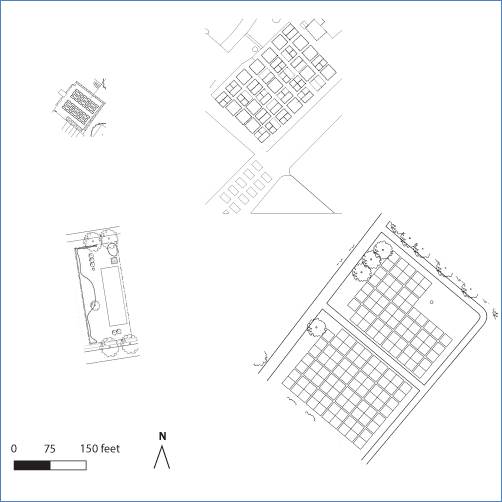
Figure 3.
Suburban Community Gardens Might Have Room to Expand. (Photo courtesy of Friends of the East Brunswick Environmental Commission.)
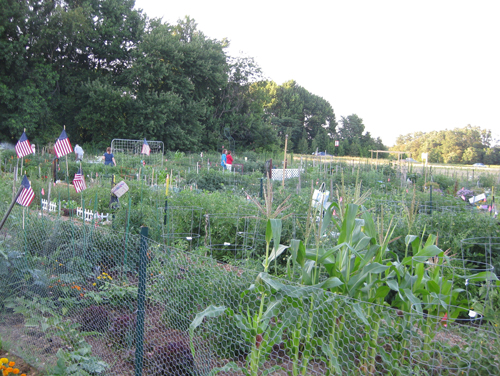
Water Management
Water delivery is a tangible aspect of garden management that links internal and external contexts. Water must first reach the garden site, and once there, it must reliably reach all parts of the garden. Urban gardens built on vacant lots or within public rights-of-way may not have water meters. In these cases, non-profit organizations and local governments may be able to subsidize the extension of water mains from nearby structures to service the garden; fire departments also use hydrants to fill rain barrels. Suburban or rural gardens may require digging or drilling wells. In cases where the garden is between two residential buildings, neighbors might allow gardeners to attach rainwater catchment systems to a house's downspout. Local regulations, though, may call for variances or other permits. As such, consistency in watering can be difficult to attain.
Once water is available, gardeners must decide how to provide water for all of the plots. Taps that are obstructed by sheds or other objects, or far away from plots, make this simple task of watering plants more difficult. One garden coordinator wanted to change the location of the tap: "We want to put in a [water] line that goes into the middle, so people don't have to pull the hose out [of the corner]." In her case, gardeners would more easily water their plots through a centrally located tap than one at the corner of the garden site. Hoses are convenient but can cause damage when dragged across other gardeners' plots. Solutions range from installing tall stakes around each plot to keep hoses on the paths to requiring gardeners to use watering cans. The decision on where to put taps within the site plays a big part in the daily use of the garden and can affect participation—the assumption being that if people find it easier to water their plots, they are more likely to participate regularly.
Conversely, automated irrigation is an option, but gardeners may lose incentive to visit the garden because it replaces some of their required labor, thus reducing social interaction or regular weeding. It also means there is additional equipment to maintain, which may be beyond gardeners' abilities. An Extension agent remarked on how irrigation in one of Atlantic City's community gardens became troublesome: "They've had so many issues here. They've dug down and split [the line], so it flooded.... I would never do another [irrigation system]; it sounds like a great idea but—well, they use the hose itself, and fill up the watering cans, so I think it's a way better idea." This last point shows how the spatial context of a garden can influence the social relationships between community gardeners, to which we turn next.
Managing Participation
Community garden management means not only encouraging members to take care of their own plots but also to share in the work of maintaining the overall site. Ideally, gardeners help maintain paths, compost, toolsheds, and other shared space and materials. When gardeners do not participate regularly, they detract from the social environment and can contribute to the spread of weeds, pests, and diseases.
"Pull" strategies encourage participation through education and social events. Community gardens across the state host orientations each spring to explain responsibilities to new members and update returning members. For instance, the New Brunswick Community Garden Coalition fosters camaraderie by hosting workshops and events that bring together gardeners from across the city. Other strategies used by garden managers across the state include harvest potlucks, which often occur throughout the year so that gardeners can prepare seasonal dishes to share from food they grew in their plots. At "seed swaps," gardeners from within the same garden, or across gardens in a city or region, share surplus seeds they have saved.
Garden managers use "push" strategies to ensure necessary work is completed. Community gardens require participation in a variety of ways, typically by asking members to contribute to shared work at various intervals, for instance, weekly, monthly, or seasonally. Weekly tasks are minor, like picking up trash and organizing toolsheds. Monthly and seasonal work includes responsibilities like mowing, mulching paths, or maintaining infrastructure such as fencing or water taps (Figure 4). In some gardens, members contribute a certain number of "volunteer labor" hours over the course of a season. In these cases, there are no official group workdays, and gardeners contribute informally on their own or with other people. Some gardens account for volunteer hours by asking members to record their time in a ledger located in the garden shed. The purpose of recording is for garden coordinators to verify that members have put in their share of work and also to foster a sense of responsibility among gardeners who know that their participation will be recorded for others to see. However, some garden coordinators acknowledge that such a system may lead to conservative estimates because not all gardeners take time to record their entries. A variation of this system is to specify volunteer hours over each month of the gardening season rather than a lump sum. In Hopatcong, New Jersey, many members of a new community garden fulfilled their yearly volunteer requirements in the first month because of the large amount of work needed to build the site. The management committee then proposed a monthly volunteering requirement to ensure that site maintenance was performed on a regular basis throughout the season.
Other sites use rotating work schedules. In this system, one or more gardeners assume all shared work for a given time period, and then those tasks would shift to another group. A garden coordinator in Maplewood, New Jersey, uses group work days along with a rotating schedule: "We do two workdays a year—one at the beginning and one at the end and you have to come. Then, I assign everyone a workweek. In that work week you have to maintain all of the common areas." This way of using just a few people to maintain the entire site works best in small gardens. In larger sites, such as those with upwards of 100 or 200 plots, a grounds committee or scheduled group workdays are best for shared work. There, volunteer labor is crucial for maintaining large amounts of green waste that can accumulate, as shown in Figure 4.
Figure 4.
Group Work Days Help to Maintain Shared Areas. (Photo by Luke Drake.)
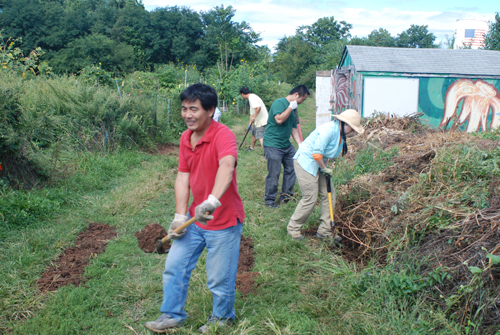
When Gardeners Quit: Abandonment
A more difficult issue comes when individuals abandon their plots. This not only detracts from the social environment, but also contributes to weeds and diseases that can affect other plots. Garden managers in our study use a variety of techniques to prevent and handle abandonment:
- Deadlines early in the gardening season to make sure members clear their plots of weeds, sow seeds, and transplant seedlings to get started in a timely manner
- Deadlines to clean up your plot at the end of the season to be able to renew the next year
- Use of "vacation flags" to alert other gardeners that you are away so that others can harvest and maintain your plot; gardeners returning to overgrown plots are more likely to quit
- Reclassifying abandoned plots as "donation plots" for local food pantries or community centers
Expulsion is seldom used because those people have stopped participating anyway; the more pressing concern is learning if the gardener intends to come back. Indeed, there is often not the conscious decision to stop gardening, but instead gardening becomes less of a priority as the season proceeds. In mid- to late-summer, family schedules get hectic as people go on vacation or juggle multiple work schedules and childcare—all during the period when frequent garden maintenance is most crucial. Heat, humidity, weeds, and insects increase the amount of time one needs to spend in the garden, but they can also discourage trips to the garden. Each case, though, calls for individual attention, and one must not assume these absences are due to lack of interest. A garden leader in East Brunswick suggests finding out what is going on in their lives by talking to them in person or over the telephone or by email:
People either weren't working [at a job] and they thought they could [participate in the garden], and now they found work and they're in the city or they can't get back until nine o'clock at night because they're working two jobs now, to try and make up for the one that they lost. (Garden leader, East Brunswick)
Once known, other gardeners can help out with someone's plot if they want to stay, or they can make arrangements to turn it over to someone else.
Outreach
Gardeners often want to engage the community beyond the garden but are not aware of the different opportunities to do so. In New Jersey, there are a variety of techniques used. Members invite non-gardening neighbors for social events, and they also distribute food to other locations. They often coordinate efforts to collect gardeners' surplus food and donate to nearby community centers or food pantries; service organizations might also obtain garden plots to grow food exclusively for their use. The following list contains some of these techniques used to engage the community through food distribution.
- Putting surplus food in "donation coolers" near the garden entrance (Figure 5); a designated gardener delivers food on a regular schedule
- Setting up a table outside the garden for passersby to take fresh food (Figure 6)
- Selling flowers, herbs, or compost as a fundraiser or social enterprise
- Staff from service organizations (e.g., food bank, Boy Scouts) using garden plots for their own distribution
- Gardeners designating plots that they will plant and harvest separately from their personal plots, and distribute that food exclusively to service organizations such as senior centers or homeless shelters
- Directly engaging the outside community by inviting non-members to participate and harvest (Figure 7)
As much as outreach is a way to engage the community beyond the garden, many community gardeners may also have concerns about vandalism and theft. However, while some gardeners opt for fencing as a necessary security measure, previous research has indicated that others consider fences as divisive barriers (Drake, 2014; Kurtz, 2001). We found similar patterns in the research for this article. The community garden shown in Figure 7 resulted from a deliberate effort by a church in Atlantic City to provide fresh food for anyone living near the garden, including homeless people. Through gardeners' intensive outreach, this garden came to be tended not only by its members but also by people from the surrounding neighborhood who were not garden members per se. In contrast, some New Brunswick community gardens with fences suffered from theft. Through interviews, gardeners suggested that theft may have occurred not through maliciousness but by confusion among non-members about the definition of community garden. That is, some passersby may assume that "community" includes non-gardeners and that it is okay to pick plants. Furthermore, theft may not only come from the outside but can also occur within gardens; building strong internal communication and relationships is thus key to mitigate internal theft.
These issues underscore the need for community gardeners and Extension professionals to conduct outreach so that such objectives and understandings are clear. Indeed, placing food (Figure 6) or setting up garden beds outside the fence have proven to be effective ways to deter theft while maintaining good relations with non-members living nearby. In suburban and rural community gardens, fencing may be necessary to deter deer and rabbits rather than people. In sum, there is no universal answer to the issue of theft and fencing, and as a result, the decision to install fencing is highly context-dependent.
Figure 5.
Donation Bin Near the Entrance of Morris County Parks Community Garden (Photo by Luke Drake)
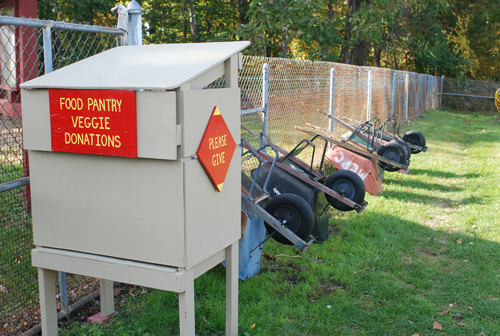
Figure 6.
Harvested Food Available for Passersby Outside of Cooper Sprouts Community Garden, Camden (Photo by Luke Drake)
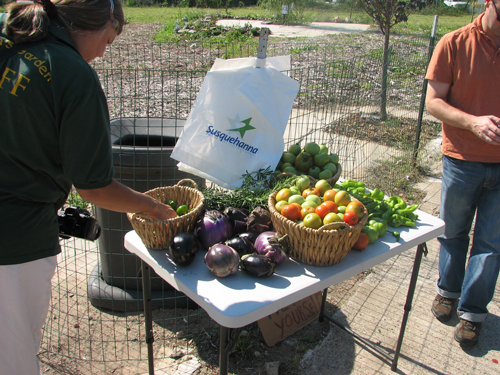
Figure 7.
No Fence Was Used so the Broader Community Can Enjoy the Garden. (Photo by Luke Drake.)
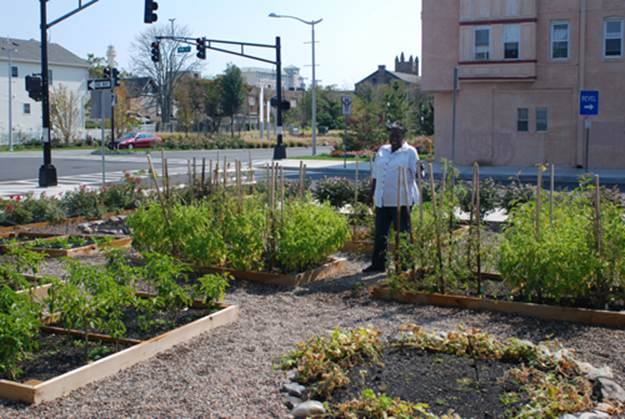
Extension Support of Community Gardens
Extension support should be tailored to how community gardens work in your area rather than uncritically transposing best practices from commercial agriculture or home gardening. Bear in mind that community gardens are likely to differ from one another in motivations and outcomes, and that they function through both individual and collective decision-making. Advice that may work for an individual gardener might conflict with broader garden rules, and advice to an overall garden may require consensus before implementation. Ask gardeners about their motivations in order to provide a range of support options, because horticultural productivity might not be their only objective. For example, if environmental stewardship accompanies food production goals, organic and permaculture techniques may be more appropriate than conventional pest and disease management. Educate gardeners on the various definitions of organic so they can decide how to proceed. Likewise, water management techniques should be considered alongside environmental and social concerns of gardeners. Community gardens do not just require water—they also require people to be active in them, watering, weeding, and doing much more. Automated irrigation may improve yields but be detrimental overall if it reduces time spent in the garden. As water conservation becomes more important it will require closer ties between Extension and gardeners to identify watering techniques that are efficient yet encourage participation. In sum, community gardens are as diverse as their locations, but awareness of how they work can help Extension professionals provide support that works in their socio-spatial environments.
Extension agents' involvement in planning and managing community garden programs, beyond offering technical advice, can be a way to build stronger and more meaningful relationships with community gardeners. Work with community garden associations to host gardening workshops—hold them in community gardens so the spatial context is immediately apparent. Work with community gardens on a regular basis to better understand how Extension knowledge intersects with garden dynamics. Conduct experiments in community gardens to better understand the effectiveness of various techniques in those settings. At a statewide scale, Extension can facilitate knowledge exchange by organizing community garden conferences. These activities have all been done by Extension faculty and staff in New Jersey with positive results. Seeing from community gardeners' points of view will help bridge Extension expertise and community concerns more productively.
Conclusions
This article contributes to Extension efforts to support community gardening by illustrating some of the key issues in community garden management. With community gardens expanding in urban and suburban areas across the U.S., Extension professionals are likely to have opportunities to engage with these activities. This geographical ubiquity calls for understanding the similarities and differences in the needs and functions of community gardens in these various contexts. Although each community garden is shaped by its own local context, they all share some characteristics that distinguish them from commercial agriculture and home gardening. Gardeners working together in close proximity on a voluntary basis present unique opportunities and challenges that require support suited for this space. By understanding the social and spatial dynamics of community gardens, Extension staff can more effectively work with community gardeners.
Acknowledgements
This research was supported by a New Jersey Agricultural Experiment Station Hatch Grant (project NJ84105). The 13 site plans used in our analysis were drawn by Arianna de Vries, Chantae Moore, Maria Torres, and Frances Turner.
References
Alaimo, K., Packnett, E., Miles, R. A., & Kruger, D. J. (2008). Fruit and vegetable intake among urban community gardeners. Journal of Nutrition Education and Behavior, 40, 94-101.
Armstrong, D. (2000). A survey of community gardens in upstate New York: Implications for health promotion and community development. Health & Place, 6, 319-327.
Bassett, T. J. (1981). Reaping on the margins: A century of community gardening in America. Landscape, 25, 1-8.
Benson, M. C. (2014). Exploring Extension involvement in farm to school program activities. Journal of Extension [On-line], 52(4) Article 4FEA4. Available at: http://www.joe.org/joe/2014august/a4.php
Boyd, B. L. (2004). Extension agents as administrators of volunteers: Competencies needed for the future. Journal of Extension [On-line], 42(2) Article 2FEA4. Available at: http://www.joe.org/joe/2004april/a4.php
Bradley, L. K., Lelekacs, J. M., Asher, C. T., & Sherk, J. T. (2014). Design matters in community gardens. Journal of Extension [On-line], 52(1) Article 1TOT9. Available at: http://www.joe.org/joe/2014february/tt9.php
Denzin, N. K., & Lincoln, Y. S. (2003). Introduction: The discipline and practice of qualitative research. In N. K. Denzin & Y. S. Lincoln (Eds.), Collecting and interpreting qualitative materials (2nd ed., pp. 1-45). Thousand Oaks: Sage Publications.
Drake, L. (2014). Governmentality in urban food production: Following "community" from intentions to outcomes. Urban Geography, 35(2), 177-196.
Drake, L., & Lawson, L. J. (2015). Results of a US and Canada community garden survey: Shared challenges in garden management amid diverse geographical and organizational contexts. Agriculture and Human Values, 32(2), 241-254.
Firth, C., Maye, D., & Pearson, D. (2011). Developing "community" in community gardens. Local Environment, 16(6), 555-568.
Hasse, J. E., & Lathrop, R. G. (2003). Land resource impact indicators of urban sprawl. Applied Geography, 23(2–3), 159-175.
Kurtz, H. E. (2001). Differentiating multiple meanings of garden and community. Urban Geography, 22(7), 656-670.
Lawson, L. J. (2005). City bountiful: A century of community gardening in America. Berkeley: University of California Press.
Lawson, L. J., & Drake, L. (2013). 2012 Community gardening organization survey. Community Greening Review, 18, 20-41.
Loria, K. (2013). Community garden information systems: Analyzing and strengthening community -based resource sharing networks. Journal of Extension [On-line], 51(2) Article 2FEA6. Available at: http://www.joe.org/joe/2013april/a6.php
Milburn, L.-A. S., & Vail, B. A. (2010). Sowing the seeds of success: Cultivating a future for community gardens. Landscape Journal, 29(1), 71-89.
Moore, A., Samuel, N., & Israel, G. (2014). Improving participation of non-traditional Extension audiences: The Empower Ocala Garden Project. Journal of Extension [On-line], 52(5) Article 5FEA4. Available at: http://www.joe.org/joe/2014october/a4.php
Nettle, C. (2014). Community gardening as social action. Farnham, Surrey, England: Ashgate.
Oberholtzer, L., Dimitri, C., & Pressman, A. (2014). Urban Agriculture in the United States: Characteristics, Challenges, and Technical Assistance Needs. Journal of Extension [On-line], 52(6) Article 6FEA1. Available at: http://www.joe.org/joe/2014december/a1.php
Patel, I. C. (1991). Gardening's socioeconomic impacts. Journal of Extension [On-line], 29(4) Article 4FEA1. Available at: http://www.joe.org/joe/1991winter/a1.php
Rohs, F. R., & Westerfield, R. R. (1996). Factors influencing volunteering in the Master Gardener program. HortTechnology, 6(3), 281-285.
Schmelzkopf, K. (2002). Incommensurability, land use, and the right to space: Community gardens in New York City Urban Geography, 23(4), 323-343.
Stone, E. (2009). The benefits of community-managed open space: community gardening in New York City. In L. Campbell & A. Wiesen (Eds.), Restorative commons: Creating health and well-being through urban landscapes. General. Technical Reports. NRS-P-39 (pp. 122-137). Northern Research Station: U.S. Department of Agriculture, Forest Service.
Turner, B. (2011). Embodied connections: sustainability, food systems and community gardens. Local Environment, 16 (6), 509-522.




